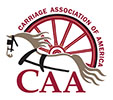A) We recently asked Gerry Glazier, who has cleaned the harness here at the CAA office as well as for several museums, what he uses. He recommends Bienenwachs Lederfit-Oel, a beeswax oil from Germany that many tack stores carry, but added that “any quality leather conditioner” can be used. We’d also like to share tips and hints that Russ Fagan shared with the CAA. Mr. Fagan was a harness maker of long experience.
Harness and saddlery keep in military stores for long periods were given a heavy dressing of “dubbin” before being packed away. This dubbin was made from pure tallow and neatsfoot oil in the proportions of three to one, by weight. A small amount of beeswax was also added sometimes. Leather treated like this was difficult to polish before all the dubbin had been removed from the surface. Dubbin should not be applied to patent leather, but it could be used on the inside surfaces of straps on harness stored away.
Some Hints For The Care and Maintenance of Harness by Russ Fagan
A good carriage and well-trained horse can offer good sport and a lot of pleasure, but even the best whip cannot prevent an accident if the harness is weak and unsafe.
General Care

A good way to keep harness soft and strong is to wash it with Ivory or Castile soap and warm, but not hot, water, scrubbing well to remove sweat and dirt. Afterwards, be sure to hang it straight, or lay it out, to dry away from sun or heat. After it is dry, apply a good lubricating dressing, preferably one made from animal oils and fats. Let this penetrate thoroughly, then rub in black paste saddle soap or yellow soap for russet harness or reins. This should be done two or three times a year, but the harness should be cleaned after every use, using a damp sponge and glycerine saddle soap, to remove sweat or mud. More frequent applications may be necessary if the harness is used often, and especially for those parts that are most exposed to sweat.
Metal hardware should also be cleaned after every use. Brass tarnishes very quickly when exposed to sweat and the dust from horses’ coats. If it is rubbed thoroughly with a clean cloth immediately after it is taken off the horse, it will be easier to polish later. (Editor’s note: Some people spray a little Endust on the cloth first, or even directly on the brass, which seems to help with this task.)
Modern patent leather is cleaned with water and dried with a soft cloth.
When a high polish is wanted on the harness for shows or special occasions, a good paste shoe polish should be used. Any accumulated polish should be scrubbed off after the show season and the leather fed. If this is not done the surface of the leather will dry and flake because of the build-up of wax.
Examination of Worn Parts
The harness should be checked each time it is used, and weak places noted for repair or replacement.
The bridle, because it is light and subject to the heat and sweat of the horse’s head, is often the first to show wear. Inspect the crown billets, and the bit billets, for wear and tears. The cheeks, at the top buckle, and just below the winker, are trouble spots.
On pair harness, the pole-straps (pole-pieces) are often left on the pole and, not consequently, do not get cleaned with the harness. As they control the vehicle, it is important that they be strong and safe. The leather center of a neck-yoke can be dangerous if allowed to become hard and dry. This weak condition is often hidden by a coat of paint.
The bit billets at the end of the reins wear through use and may also get chewed. These should be watched, as also should the body of pair reins where the coupling reins (inside cheeks) buckle in; this part takes a lot of strain and needs extra care.
The breastplate (or choke-strap or false martingale) gets a lot of heat and sweat where it passes between the horse’s legs, and, with harness that has the breeching attached to the center of the girth, the breastplate has to play a part in holding back the carriage. It needs to be kept in sound, supple condition with extra feeding.

All styles of single harness have some sort of safety strap to hold down the shafts. This may be a straight bellyband, or there can be wrap straps, but they must be strong and pliable. If the safety strap breaks, the horse has no way of controlling the vehicle and it can run up under him, or, in the case of a two-wheeler, it can upset backwards. Breeching straps (or hold-back straps) are sometimes fitted with snap hooks and may be left on the shafts without getting the attention they need. Since they are as important to a single horse as the pole straps are to a pair, they should get special care.
All parts of the harness need to be looked after, and the above are those that need repair most frequently.
From the Summer 1997, Vol. 35, No. 1 edition of The Carriage Journal.
